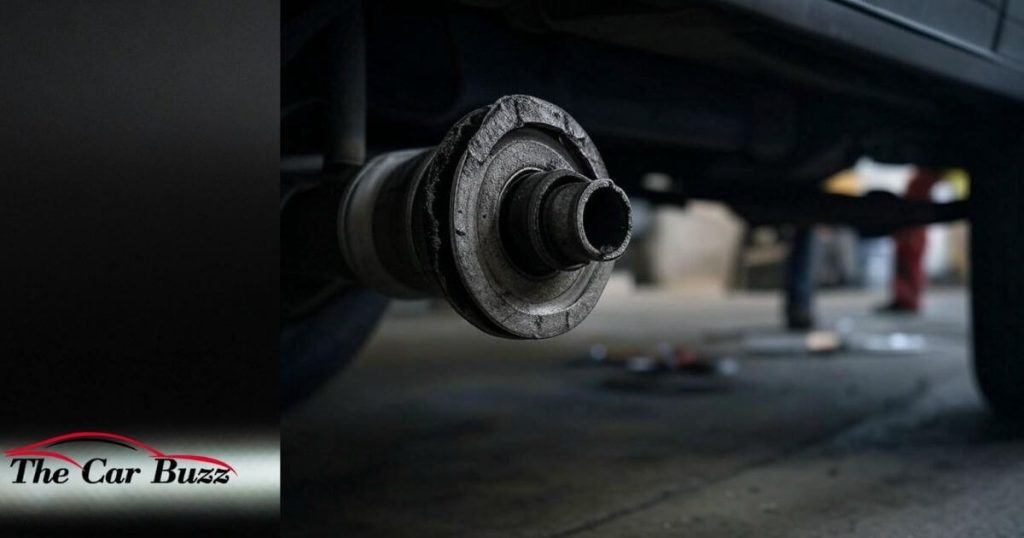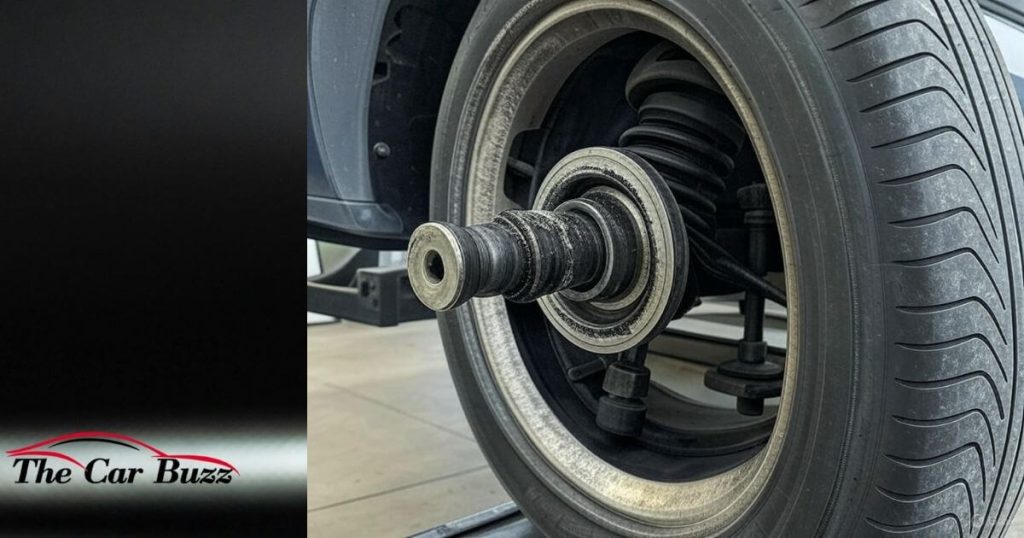Last Updated on April 9, 2025 by Mark S. Taylor
If you’re hearing clicking sounds when turning or feel strange shakes while driving, you’ve probably wondered how to tell if CV shaft is bad. I’ve been through it myself—confused by odd noises, unsure what to check, and nearly ended up stranded. A worn CV joint can sneak up on you, but once you know the signs, it’s easier to spot. In this article, I’ll break it down in plain language, share what helped me, and show you how to test CV joints the right way. Stick around—I’ll help you figure out what’s really going on under your car.

Contents
What Is a CV Shaft and Why It Matters
Let me be honest—I had no clue what a CV axle was until mine gave out on a rainy morning. One minute I was cruising, the next I heard a nasty pop and lost all power to the wheels. That was the day I learned the hard way what a CV shaft does.
In simple terms, the CV shaft (also called a CV axle) connects your car’s transmission to the wheels. It helps transfer power while letting the wheels move up and down with the suspension and turn with the steering. So, if you’ve ever wondered CV axle what is—that’s it. No power, no movement, no going anywhere.
Think of it like your legs when biking. If your knee joint locks or breaks, you’re not going to pedal smoothly—or at all. It’s the same with your CV shaft. That little joint carries a big load. And when it fails, the car feels off in ways you don’t expect.
Knowing what the CV shaft does is the first step in figuring out how to tell if CV shaft is bad. It’s a simple part with a big job, and trust me, ignoring it will cost you more than a quiet Sunday morning under the hood.
Early Warning Signs of a Bad CV Shaft
I first noticed a faint clicking noise when pulling out of a driveway. At first, I thought it was a loose hubcap. But the sound got sharper each time I turned the wheel. That’s when I learned that a clicking noise while turning is one of the earliest bad CV joint symptoms—and one you shouldn’t ignore.
Another red flag? A clunking sound when accelerating. It feels like something’s shifting under the car, almost like the drivetrain jerks into place. That clunk was my CV shaft warning me before it got worse.
Then came the vibration during acceleration. Not the slight hum you get from tires—this was deep and rough, almost like the steering wheel was buzzing in my hands. A bad CV shaft can create uneven movement, leading to CV shaft vibration that gets worse at high speeds.
And finally, the pull. My car started to shake and drift slightly to one side, even on straight roads. Turns out, a worn CV joint messes with balance and handling, making your car feel like it’s fighting itself.
Quick takeaway: If your car starts making odd noises or shakes while turning or driving straight, don’t wait. These are classic signs of CV trouble. Catching it early can save your axle—and your wallet.
How to Test CV Joints and Tell Which One Is Bad
Testing your CV joints isn’t as hard as it sounds—you just need a sharp eye and a few minutes of patience. I once spotted a grease splatter near the front tire and almost ignored it. Good thing I didn’t. That tiny mess was a sign my CV boot had torn, and the joint was on its way out.
To start, check around the CV boots (those rubber sleeves near your wheel). Look for cracks, splits, or grease leaks. If you spot any, that’s your first clue. That’s how to inspect a CV shaft without any tools—just your eyes and a flashlight.
Next, lift the car safely using a jack and secure it with stands. Grab the axle near the joint and try to wiggle it back and forth. If there’s play or clicking, that’s a sign of a worn CV joint. A good joint should feel tight, with no extra movement.
Take it for a short drive too. Do slow, tight turns in an empty parking lot. Listen for clicking noises—they usually point to the outer joint. If you hear clunks or feel vibration during straight-line acceleration, the inner joint might be the problem.
So if you’re asking how to test CV joints or how to tell which CV joint is bad, just follow this process: check for grease, test the play, and listen while you drive. It’s simple, and it might save you from a bigger repair later.
How CV Boot Damage Leads to Joint Failure
The CV boot is like a protective glove for your CV joint. It holds in the grease and keeps out dirt and water. When the boot cracks or tears, the joint is left exposed—and that’s where the trouble starts. I learned this the hard way. Mine tore clean through. I kept driving—and paid for it later.
At first, I just noticed grease leaking from the CV joint, splattered on the inside of my wheel. I brushed it off, thinking it was no big deal. But that grease is what keeps the joint moving smoothly. Without it, metal grinds on metal, and the joint starts wearing down fast.
If you’ve ever wondered what happens if you drive with a bad CV axle boot, the answer is simple: you risk full joint failure. Dirt gets in, grease gets out, and soon, the clicking and clunking starts. Before you know it, you’re stuck needing a full axle replacement.
Tip: If you spot CV boot damage, don’t wait. Replacing just the boot is cheaper than replacing the entire CV shaft. A small fix now can save you from a major headache down the road.

Can a Bad CV Joint Affect Other Car Parts?
When my CV joint started to go bad, I thought my transmission was failing. The jerks, the strange noise, the lag—it all felt like something bigger. Turns out, it was just the CV joint. But the way it affected the drive made me question everything.
A bad CV joint doesn’t just stay in its lane. It can mess with the transmission, especially if the axle shifts too much or loses contact. You might feel rough gear changes or delayed acceleration. It’s not the transmission’s fault—it’s the joint pulling everything out of sync.
It also puts stress on the suspension and steering. When the joint isn’t smooth, your wheels don’t move right. This leads to uneven tire wear, shaky handling, and more front axle problems. It’s like trying to run with a twisted ankle—you’ll still move, but not well.
So if you’re asking can a bad CV joint affect the transmission, the short answer is yes, indirectly—but the damage can spread fast. Fixing it early saves more than just your axle. It saves the whole ride.
What Happens If You Ignore a Bad CV Shaft?
I get it—life’s busy, and car repairs can wait… until they can’t. I once told myself I could drive “just a few more days” with a clicking CV joint. That decision ended with a loud pop, a locked front wheel, and a full tow and axle replacement. Not worth it.
If you’re asking how long can you drive with a damaged CV joint, the honest answer is: not long. A bad CV shaft can fail suddenly. And when it does, your wheel can lose power—or worse, detach while driving. That’s not just scary—it’s dangerous.
You might also wonder is my CV axle broken if you hear loud noises, feel strong vibration, or notice the car pulling. Ignoring these signs means risking damage to nearby parts like the transmission, suspension, or even the brakes.
Bottom line: the longer you wait, the higher the risk—and the repair bill. Catching it early can save you from roadside trouble and a major expense.
When and Why to Replace the CV Shaft
There’s a point where patching things just doesn’t cut it anymore—and that’s exactly how I felt staring at a split boot and grease-covered wheel. I’d already ignored the signs: vibration, clicking, and a clunk when taking off. Those are all classic CV axle symptoms, and they only get worse.
If you’re hearing those sounds, seeing grease leaks, or feeling uneven motion, you’re likely looking at signs of a bad CV joint. And if the damage has spread, it’s time for a full shaft replacement. Waiting too long can cause the joint to snap—and that’s a much costlier fix.
Speaking of cost, the CV shaft replacement cost usually ranges from $300 to $800, depending on your car and whether you go to a shop or dealership. I once tried to save money by doing it myself. Let’s just say… never again without the right tools and a solid lift.
If you’re not 100% confident—or if you don’t have a garage and the gear—don’t risk it. A pro can get it done faster and safer. And sometimes, peace of mind is worth the price.
Frequently Asked Questions (FAQ)
How to tell if front CV joint is bad?
Listen for clicking noises when turning or check for grease leaks. Vibration or shaking at high speeds also signals a bad CV joint. Inspect the CV boot for tears.
What does a bad CV joint sound like?
A bad CV joint makes clicking or clunking noises when turning or accelerating. You might hear it most when driving straight or at high speeds.
Can a bad CV joint cause transmission problems?
Yes, a bad CV joint can mimic transmission issues, but it won’t directly harm it. It can affect handling and cause vibrations, though.
Is it safe to drive with a bad CV joint?
No, it’s not safe. Driving with a bad CV joint risks axle failure or wheel detachment. Get it checked and fixed fast.
What are common CV axle symptoms?
Common signs include clicking noises, vibrations, grease leaks, and shaking. A torn CV boot or clunking when accelerating also indicates trouble.
Final Thoughts: how to tell if cv shaft is bad
If you’re someone who wants to save money and stay safe on the road, spotting CV shaft issues early is a must—trust me, I learned the hard way when my car started clicking on a rainy night. But if you’re not ready to tackle car maintenance or prefer leaving it to pros, you might want to skip the DIY route. Based on my experience, catching signs like bad CV joint symptoms or grease leaks can prevent big repairs, like when I ignored mine and ended up needing a tow. Think of it like catching a small leak before your roof caves in—it’s simple but crucial. So, if you hear clicks, feel shakes, or see grease, check it now or get it checked—it’s not worth the risk!
